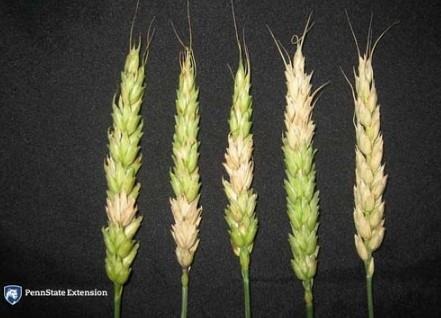By Alyssa Collins
It’s time to see how your disease management approach worked in your wheat and barley. If you had disease, here’s what to do about it.
Wheat continues to flower in the northern part of PA, so as yours comes into flower be sure to check your risk of scab (works best in Mozilla Firefox browser).
Figure 1. Infected wheat heads.
Wheat that flowered two weeks ago will begin to show symptoms of scab next week or so (it takes about three weeks from infection to see symptoms). These symptoms are easiest to see before the wheat turns straw-colored. Bleached spikelets will be apparent in an otherwise green head, and upon closer examination an orange-pink cast can be seen. In Figure 1, we see some infected heads in the field and Figure 2 shows the scope of infection patterns possible with this disease. It is important to note that the level of head scab in your field does not always match the level of DON (vomitoxin) in your harvested wheat, but it is generally a good indicator. This has to do with the biology of the fungus. Also, many spikes that were affected by scab may not fill, subsequently the lightweight infected grain may be removed with the chaff. Start scouting fields about 3 weeks after flowering to determine the level of infection. Heads that are infected after the flowering stage may not have time to show symptoms before maturity. If you are having a hard time distinguishing symptoms of head diseases, refer to Kansas State University's publication: Identifying Wheat Diseases Affecting Heads and Grains.

Figure 2. Range of infection patterns in wheat.
Barley may also be showing symptoms, but these are not as drastic as those seen in wheat and are difficult to distinguish from other head diseases. If conditions are right, you may see some fuzzy fungal growth or orange sporulation which will help confirm scab (Figure 3).
Figure 3. Head scab in barley
Even those farmers that applied a timely spray to at-risk small grains may see some symptom development. This is because even the best products applied at the perfect time (at the onset of flowering) do not give 100% protection. At best, these fungicides can offer a 50-60% reduction in disease severity and, ultimately, DON production. If a spray was applied before flowering, disease control will be even less.
If you find you have more than 25% of your heads affected by scab, consider harvesting it using a high fan speed on your combine which helps to clean out the lighter, infected kernels (which are highest in DON). Harvest these fields as soon as you can, since the longer they stay in the field, the worse they’ll get. Another option is to attempt to segregate scabby fields from clean ones during harvest. Fields often have levels of infection that vary on the edges or from field to field based on planting date, flowering date, and variety.
Check with your crop insurance agent to understand the proper procedure for harvest and testing if you suspect you may have a problem with DON this year.
Leaf Diseases
If you treated your grains at flowering with one of the recommended products, you will also get some control of the leaf diseases present at this time in many fields. Diseases spotted recently have included leaf and stripe rust, leaf blotch complex diseases, and still some powdery mildew. It’s a good time to start checking your crop for flag leaf and head disease symptoms to get an idea of how your disease control approach worked and what kind of quality you can expect at harvest.